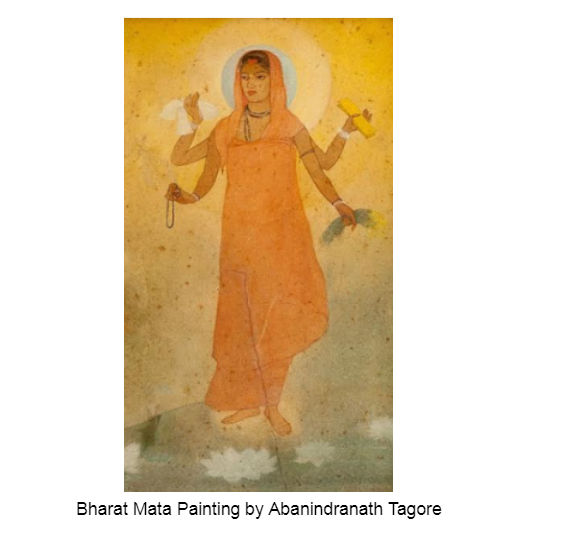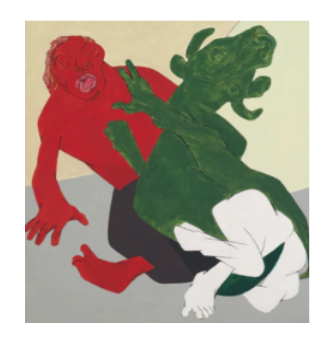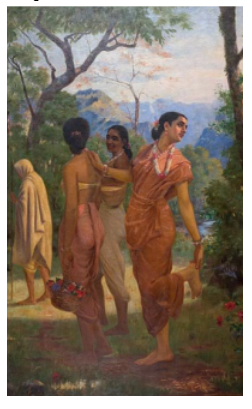Personalities Associated to Paintings
Relevance : GS-1 (Indian Heritage and Culture)
PAINTINGS OF INDIA
- The tradition of painting has been a part of Indian culture for a long time.
- Indian classical paintings have changed over the years, influenced by different traditions.
- These paintings were initially connected to religion but later combined various cultural influences.
- Western ideas began to impact Indian art during the colonial period.
- After India gained independence in 1947, different art schools emerged, bringing modern techniques and thoughts.
- Art galleries were set up to display these artworks.
- Indian art received a boost with the country's economic changes in the early 1990s.
- Artists from different fields brought in various styles of work.
- As a result, Indian art now goes beyond traditional academic boundaries.
GENRES OF INDIAN PAINTING
1. Cave Painting:
Prehistoric cave paintings in India, like those in Ajanta, Ellora, Bagh, and Sittanavasal, emphasise naturalism.
2.Madhubani Painting:
Originating in a Bihar village, Madhubani paintings were initially drawn by women on their home walls, reflecting their thoughts and dreams.
3.Miniature Painting:
Small, handmade paintings known for intricate and delicate brushwork, often colourful but small in size.
4.Mughal Painting:
A blend of Indian, Persian, and Islamic styles, Mughal paintings were confined to book illustrations and miniatures during the Mughal empire.
5. Mysore Painting:
Evolving in Karnataka's Mysore city, these paintings feature muted colours and attention to detail, often depicting Hindu gods and goddesses.
6.Rajput Painting:
Originating in Rajasthan's royal states, Rajput paintings depict themes from epics, Krishna's life, landscapes, and more, using miniatures as a preferred medium.
7.Tanjore Painting:
Hailing from Tamil-Nadu's Thanjavur city, Tanjore paintings are known for dense composition, vibrant colours, and depictions of Hindu mythology scenes.
8.Pattachitra:
Folk paintings from Orissa, often linked with the worship of Lord Jagannath, utilizing vegetable and mineral colours prepared by the artists themselves.
9.Bengal schools of painting:
Flourishing during the British Raj, the Bengal School of Art was associated with Indian nationalism and was promoted by both Indian and British art administrators.
PERSONALITIES OF INDIAN PAINTING
1. Rabindranath Tagore
He started painting from 1893 onwards and emerged as a creative exponent of graphic art in 1928.
- Artistic Style: His poetry and prose reflect traditional Bengali and Indian influences, while his paintings showcase his unique imagination and creativity.
- Western Influence: His paintings might also draw from his deep understanding of contemporary Western art.
- Promotion of Art: Tagore encouraged young artists by opening his house to them and establishing the "Vichitra Club."
- Kala Bhavan: He founded Kala Bhavan at Visva Bharati University in 1919.
- Tagore’s best known painting, Bharat Mata, depicted a young woman, portrayed with four arms in the manner of Hindu, deities, holding objects symbolic of India’s national aspirations.
- Rabindranath Tagore became the first Indian artist to display his work in Europe, Russia, and the United States in 1930.
2. Abanindranath Tagore
Renowned as India's greatest painter, he was the nephew of Bengali poet Rabindranath Tagore.
- Establishing Institutions: Founded the "Indian Society of Oriental Art" in and the Bengal School of Art to counter the influence of English culture on Indian artists.
- Modernising Art: Aimed to modernise Rajput and Mughal paintings through the Bengal School of Art, contributing to the development of modern Indian painting.
- His first expression of paintings was the Radhakrishna series.
- His set of paintings called Krishnalila (1896) is a synthesis of the Indian and European styles.
- His Arabian Nights series (1930) is among his most renowned works.
- His other important paintings include : The Lovelorn Yaksha, The Omar Khayyam series, A Drop of Tear on a Lotus Leaf, Devadasi, Sun worship, etc.
- Accomplished Writer: Known for his writing, especially for young readers, with notable works like BudoAngla, Khirer Putul, and Rajkahini among the finest examples of Bengali children's literature.
(i) Bharat Mata
- Abanindranath Tagore created the Bharat Mata painting in 1905.
- Depiction: The painting portrays Bharat Mata with four hands, each holding something significant, reflecting Indian traditions prominent in Tagore's works.
- Inspiration: Tagore drew inspiration from Bankim Chandra Chattopadhyay's 1882 novel Anandamath, which beautifully describes the motherland.

(ii) The Victory of Buddha
Shows Buddha after enlightenment, addressing the question of human suffering.
(iii) Passing of Shah Jahan
Illustrates Shah Jahan on his deathbed, trying to view the Taj Mahal, where he wanted to be laid to rest.
(iv) Journey's End
Painted in 1913, depicts a weary camel appearing relieved rather than joyful at the end of its journey.
3. Jamini Roy
- Renowned Indian painter known for blending traditional Indian and Western art to create distinctive artworks.
- Recognition: Awarded the Padma Bhushan in 1955, one of India's highest civilian honours.
- Art Collections: His works are featured in various collections, such as the National Gallery of Modern Art in New Delhi, the Harn Museum of Art at the University of Florida, and the Victoria and Albert Museum in London.
- Important works include -
(i) Three Pujarins
- Depicts three praying women, using bold black lines and simple blue colours.
- Artistic Shift: Jamini Roy transitioned from European oil medium to conventional plant and mineral-based colours in the 1920s.
- Village Life Reflection: His artworks often portrayed aspects of rural life, respecting peasants, artisans, and individuals from religious and tribal communities.
- Influences and Style: Inspired by folk tales and rural narratives, he depicted subjects considered sacred by the people.
- Signature and Detail: The painting bears the Bengali signature "Jamini Roy" in red, emphasizing the artist's identity.

4. Amrita Shergil
Renowned Indian painter known as the "Frida Kahlo of India," referencing the famous Mexican painter.
- Pioneer of Contemporary Art: Considered the founder of contemporary (modern) art in India and a pioneering female artist.
- Artistic Evolution: Initially influenced by Western styles, she later rediscovered her artistic identity by depicting Indian subjects in a traditional manner.
- Influences: Her works were influenced by Mughal and Ajanta paintings, as well as by the works of Rabindranath Tagore and Abanindranath Tagore.
- Her artworks reflected her worries about poverty.
- Some of her famous paintings include Bride's Toilet, Hill Women, Siesta, Nudes, and Brahmacharis. She passed away at the young age of 28.
(i) Self-Portrait
A renowned painting by Amrita Sher-Gil, one of India's greatest painters. The artwork blends the artist's Indian features with contemporary European-inspired techniques, reflecting a fusion of Indian and European styles as well as classic and modern Indian art.
5. Saiyed Haider Raza (S.H. Raza)
- Background: S.H. Raza hailed from a humble background and initially struggled to enrol in the J.J School of Art in Mumbai.
- Early Life Struggles: To sustain himself, he took up work at a block maker's studio, where he created notable paintings reflecting daily life.
- Artistic Maturity: Despite his youth, his paintings showcased a deep understanding of art, leading to his recognition as a founding member of the Progressive Artists Group.
- Inspirations: Fascinated by beliefs, culture, and origins, Raza's adoption of 'Bindu' brought new dimensions to his limited subject matter and theme.
- Notable Works: Raza also produced captivating paintings based on the concept of Tribhuj (Triangle).
- Awards: He was awarded the Padma Shri and Fellowship of the Lalit Kala Academy in 1981 and Padma Bhushan in 2007.
(i) Composition Geometrique
"Composition Geometrique" is a renowned artwork by Sayed Haider Raza, a celebrated Indian artist, completed in 2007.

6. M.F. Hussain
- M.F. Hussain is recognized as a leading figure in Indian art.
- His paintings often portray the black social environment with distorted human figures, horses, and objects.
- Some of his notable works are based on themes like Ramayana, Mahabharata, Mother Teresa, and the British Raj.
- His style bears the influence of renowned artists such as Picasso, Gris, and Leger.
7. Tyeb Mehta
- He lived a modest life and created a notable painting depicting the Hindu mythological demon being defeated by a goddess.
- Record-breaking Sale: The artwork was sold for INR 11 crore at a Christie's auction in 2005, marking the first instance of a contemporary Indian art piece selling for over a million dollars.
- Renowned Indian painter credited with sparking greater interest in Indian art globally.
- Association: A member of the Bombay Progressive Artists' Group, he shared ideas with other prominent members of the group.
- Diagonal Series: Known for the Diagonal Series, which inadvertently became his signature style.
(i) Mahisasur
This artwork portrays Mahishasura embracing Goddess Durga. It gained worldwide acclaim as the first Indian artwork to sell for over a million dollars in the international market.

8. Satish Gujral
Renowned Indian painter known for his exploration of architectural perspectives in paintings.
- Architectural Work: Responsible for the construction of the Belgium Embassy in New Delhi, showcasing his multifaceted talents.
- Awards: Awarded the Padma Vibhushan, the second-highest civilian award of the Republic of India, in 1999, in recognition of his contributions.
- Famous Paintings: Notable works by Satish Gujral include "Days of Glory," "Trees of Life," and "Meera Bai."
(i) Days of Glory
It is a renowned masterpiece by Satish Gujral, created in 1952. It is famously known as the "Partition of India" painting.

9. Dhiraj Choudhury
- Artistic Orientation: Known as an idea-oriented artist, she can deeply engage with suggested themes in her work.
- Exhibition Experience: Has showcased art in over 75 solo exhibitions in major Indian cities and 12 one-man shows internationally in countries such as France, the United Kingdom, the US, Switzerland, and Singapore.
- Significant Achievement: Sole Indian participant in the 1976 Geneva Exhibition of Art, highlighting her international recognition.
- Recent Works: Currently focusing on a series titled "Love at the Threshold of the New Millennium," with collections like 'World without Love,' 'Love,' and 'Nothing is more beautiful than Love.'
- Accolades: Honoured with several awards, including the National Award of the Lalit Kala Academy.
10. A. Ramachandran
- Artist Background: Born in Attingal, Kerala, he is a renowned and talented Indian painter.
- Artistic Style: Influenced by Kerala temple murals and tribal art, he is a figurative painter known for his skillful use of light and shade technique.
- Visual Drama: Demonstrates a strong command of lines, colours, and forms, creating visually stimulating artwork.
- Accolades: Awarded the Padma Bhushan in 2005, and elected a Fellow of the Lalit Kala Academy in 2002, highlighting his significant contributions to the arts.
11. Raja Ravi Varma
Known as the 'Father of Indian Modern Art,' born in Kilimanoor (now in Kerala) in 1848.
- Early Career: Produced portraits of elite society members and British officials between 1870 and 1878.
- International Recognition: His artworks were displayed at the 1873 Vienna exhibition, leading to global acclaim.
- Notable Sale: His painting 'Radha in Moonlight' was auctioned for INR 24 crore.
- Subject Matter: Often portrayed scenes from the Mahabharata ( story of Dushyanta and Shakuntala, and Nala and Damayanti) , Ramayana, and ancient mythological tales from the Puranas.
- Artistic Fusion: Successfully combined Indian cultural themes with European academic art methods. He introduced oil painting in India.
- Emphasis on South Indian Women: His artworks celebrated the beauty of South Indian women, capturing the admiration of many.
- Cultural Influence: Varma's depictions of Hindu deities inspired worship among people from lower social classes.
(i) Shakuntala
A renowned handmade oil painting by Raja Ravi Varma, a famous Indian artist.
- Depiction: Represents a modern-day adaptation of the search for Dushyanta from the Mahabharatha epic, with Shakuntala pretending to remove a thorn from her foot while scanning for her lover.

- Artistic Details: Showcases Shakuntala with graceful beauty and sensuality, reflecting the joyful and lively tone of the painting.
- Scene Setting: Features Shakuntala's companions engaged in conversation, while a hooded figure with a cane is spotted in the distance.
12. S L Haldankar
- Sawlaram Lakshman Haldankar established the Haldankar Fine Arts Institute in 1908.
- Art Society of India: Co-founded the Art Society of India in 1918, serving as its first president.
- Watercolour Expertise: Renowned for his exceptional watercolour artworks, showcasing his mastery in this medium.
- International Recognition: His artwork has been exhibited in Bombay, Madras, Simla, and the Royal Society of British Artists in London. He was honoured by Dr. Rajendra Prasad, the first President of India.
- Global Acclaim: Listed as one of the world's top three watercolorists in an Italian encyclopaedia, emphasising his international reputation.
(i) The Glow of Hope
- He is known for the famous artwork "Glow of Hope" or "Woman With the Lamp."
- Artwork Display: The painting is currently exhibited at the Jaganmohan Palace in Mysore at the Sri Jayachamarajendra Art Gallery.
- Gita Haldankar: The young girl portrayed in the painting is Gita Haldankar, the daughter of S.L. Halankar.
- Related Work: Haldankar also created another painting titled "Divine Flame" featuring his second daughter, Lilavati, following the same theme as "Glow of Hope."
13. Vasudeo S Gaitonde
A renowned painter, who gained prominence in the late 1950s for his non-objective or non-figurative style of painting.
- Background: Vasudeo S Gaitonde, born in Nagpur, Maharashtra, was renowned for his abstract art.
- Accolades: Received the Padma Shri in 1971 for his significant contributions to the field of art.
- Untitled Works: Despite his recognition, he often left his paintings untitled, reflecting his aversion to words.
- Simple Living: Chose to reside in a one-room apartment in Delhi's Nizamuddin East, dedicating most of his time to creating his exclusive artworks.
- Famous Painting:
(i) Painting 4
Painting 4 is an oil painting on canvas. It was made by Vasudeo S Gaitonde in 1972.
14.Nandalal Bose
Renowned Indian painter influenced by Abanindranath Tagore's art.
- Exhibitions: Held his first art exhibition in 1911, followed by displays at national and international exhibitions, including those in the Netherlands, England, and Paris.
- National Presence: His artworks were exhibited at Indian National Congress sessions in Lucknow and Haripura, gaining significant recognition.
- "Nine Masters": Recognized by the Archaeological Survey of India in 1976 for the artistic and aesthetic value of his works.
- Awards: Conferred with the Padma Bhushan in 1954 and recognized by Santiniketan in 1921 for his contributions to the field of art.
(i) Bapuji
- Nandalal Bose's famous linocut print portrayed Mahatma Gandhi's Dandi March, serving as a symbol of the nonviolent movement.
- Artistic Recognition: Bose gained recognition for his originality and support of individual freedom through his artwork.
- Role in Government Affairs: Post-Independence, Bose rose to prominence in Indian government affairs, contributing to the design of the Indian Constitution's manuscript.
- Symbol Design: Entrusted by Jawaharlal Nehru, India's then-prime minister, with creating symbols for significant government honours like the Bharat Ratna and Padma Shri.

Conclusion
The world of art has been significantly enriched by the contributions of various celebrated Indian painters such as Raja Ravi Varma, Amrita Sher-Gil, Jamini Roy, Nandalal Bose, and Sayed Haider Raza, among others.
Their innovative styles, diverse influences, and dedication to showcasing Indian culture and traditions have not only left an indelible mark on the Indian art scene but have also garnered international recognition, making them invaluable assets to the global art community.
FAQs
1.Who is considered the "Father of Indian Modern Art"?
A: Raja Ravi Varma is regarded as the "Father of Indian Modern Art" for his significant contributions to Indian art during the late 19th and early 20th centuries.
2.What is the significance of the Bengal School of Art in Indian art history?
A: The Bengal School of Art was a significant artistic movement in India during the British Raj, emphasising a revival of Indian art traditions and contributing to the development of modern Indian art.
3.How did Amrita Sher-Gil contribute to Indian art?
A: Amrita Sher-Gil, often referred to as the "Frida Kahlo of India," is known for her pioneering role in the Indian art world, blending Western and Indian artistic styles in her paintings.
4.What is the contribution of Jamini Roy to Indian art?
A: Jamini Roy is recognized for his unique style that combined traditional Indian folk and village art with modernist influences, making his works highly influential in the development of modern Indian art.
5.How did Nandalal Bose impact Indian art and culture?
A: Nandalal Bose, a prominent figure in the Bengal School of Art, significantly contributed to the revitalization of traditional Indian art forms and played a crucial role in the development of modern Indian art and culture.


